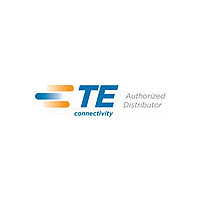1055478-1 TE Connectivity, 1055478-1 Datasheet - Page 115

1055478-1
Manufacturer Part Number
1055478-1
Description
Connector Accessories Cable Bender
Manufacturer
TE Connectivity
Type
Benderr
Datasheet
1.1055478-1.pdf
(126 pages)
Specifications of 1055478-1
Lead Free Status / RoHS Status
RoHS Not Applicable
Theory and Application
As a leading manufacturer of RF products, Tyco Electronics
produces a large variety of coaxial connectors. The proper
selection and application of these connectors requires a knowl-
edge of factors not involved in other types of connectors and
terminals. The following paragraphs have been prepared to
improve understanding of the theory behind RF connectors:
Basic RF Theory
RF energy travels by electromagnetic waves, and it is pri-
marily the frequency of these waves that we are interested
in. Briefly, if an oscillating voltage source is connected to a
cable, a continuous electromagnetic wave will propagate
along the cable. A sensor placed at some point on the
cable would indicate a varying voltage (E field) as well as a
current and magnetic field (H field) as the wave travels past
it. This is called an electromagnetic wave because both
electric and magnetic fields are varying. The wave shape is
initially determined by the variation of the source with time.
Figure 7 shows the radiant energy spectrum. Visible light,
radio, television, x-rays and Gamma rays are all phenome-
non of electromagnetic waves at different frequencies. This
introduction will treat only those that are generated by an
electrical source and propagated along a physical cable or
other transmission media. That is, frequencies above zero
and up to about 50 gigahertz.
1
Catalog 1308940
Revised 5-03
www.tycoelectronics.com
Frequency or
The majority of the technical terms, relative to RF and coaxial cable and
connectors, used here-in and throughout this catalog are defined in the
Glossary of Terms in Section 18.
Wavelengths
0 - 29.9
KHz
30 - 299.9
KHz
300 - 2999.9
KHz
3 - 29.9
MHz
30 - 299.9
MHz
300 - 2999.9
MHz
3 - 29.9
GHz
30 - 299.9
GHz
Notes:
1. KHz = Kilohertz (1 thousand cycles per second)
2. MHz = Megahertz (1 million cycles per second)
3. GHz = Gigahertz (1 billion cycles per second)
Designation
VLF
(Very Low
LF
(Low sonar
MF
(Medium
Frequency)
HF
(High
Frequency)
VHF
(Very High
UHF
(Ultra-high
Frequency)
SHF
(Super High
Frequency)
EHF
(Extremely High
Frequency)
1
Frequency)
Frequency)
Frequency)
Radiant Energy Spectrum
Dimensions are in inches and
millimeters unless otherwise
specified. Values in brackets
are metric equivalents.
Figure 7
RF Connectors
Appendix A - Theory and Application
Commercial AC electricity, deep
depth sounders, ultrasonic
grinders, sonic oscillators
Shallow-to-medium depth sounders
Commercial AM radio broadcasting,
marine radio telephone, direction
finders
Citizen band radio, amateur radio,
international broadcasting
VHF television (Channels 2 thru
13), commercial FM radio
broadcasting, amateur radio, fire
and police radio
UHF television (Channels 14 thru
83), microwave ovens, aeronautical
radionavigation
Microwave communications, marine
radar, aircraft tracking and
airborne radars
Space communications, radio
astronomy
Applications
Dimensions are shown for
reference purposes only.
Specifications subject
to change.
In the following paragraphs we will discuss waves in greater
detail, including the relationship of frequency and wave length,
how pulses are formed and used, how each differs from the
other and the problems involved in their transmission.
Sine Waves
An RF wave is a sine wave, meaning that it smoothly swings
from zero to a positive peak value, then back down past zero
to a negative peak value, then back to zero to complete a
360 electrical degree cycle. The positive and negative
peaks are always equal in amplitude. The two qualities
which characterize this type of wave are amplitude and fre-
quency (f). Figure 8 shows these two characteristics.
Amplitude refers to the peak value attained by the wave and
corresponds to voltage. Frequency refers to the number of
oscillations per second. For example, the sign wave in
Figure 8(B) has completed 12 cycles in one second.
Therefore, we would say that this wave has a frequency of 12
cycles per second or 12 Hertz. The time for one complete
cycle is defined as the period (T). The relationship between
the period and frequency is given by the equation:
The wave travels away from the generator at speeds approach-
ing the speed of light. When an electromagnetic wave travels in
a medium other than air or vacuum, the speed for the wave is
reduced by a factor of the square root of the dielectric constant
( . The velocity (v) of the propagation of a signal is given by:
Where c is the speed of light, 3 x 10
in/sec, and is the dielectric constant of the medium.
(See Table 1 for dielectric constants of various materials)
The wavelength of a signal is given by the formula
See Figure 9
Peak
Positive
Amplitude
1
1
USA: 1-800-522-6752
Canada: 1-905-470-4425
Mexico: 01-800-733-8926
C. America: 52-55-5-729-0425
2
2
Typical Sine Wave Characteristics
= v/f = __________
3
3
4
4
f = 1 / T in Hertz
5
5
No. of Cycles
x f (GHz)
A
B
One Cycle
6
1 Second
Figure 8
v=
6
c
7
__
c
7
South America: 55-11-3611-1514
Hong Kong: 852-2735-1628
Japan: 81-44-844-8013
UK: 44-141-810-8967
8
8
8
_________ inches
1.18 x 10
m/sec or 1.18 x 10
9
x f (GHz)
9
10
10
10
11
11
12
12
Peak
Negative
Amplitude
10
7115
7
























